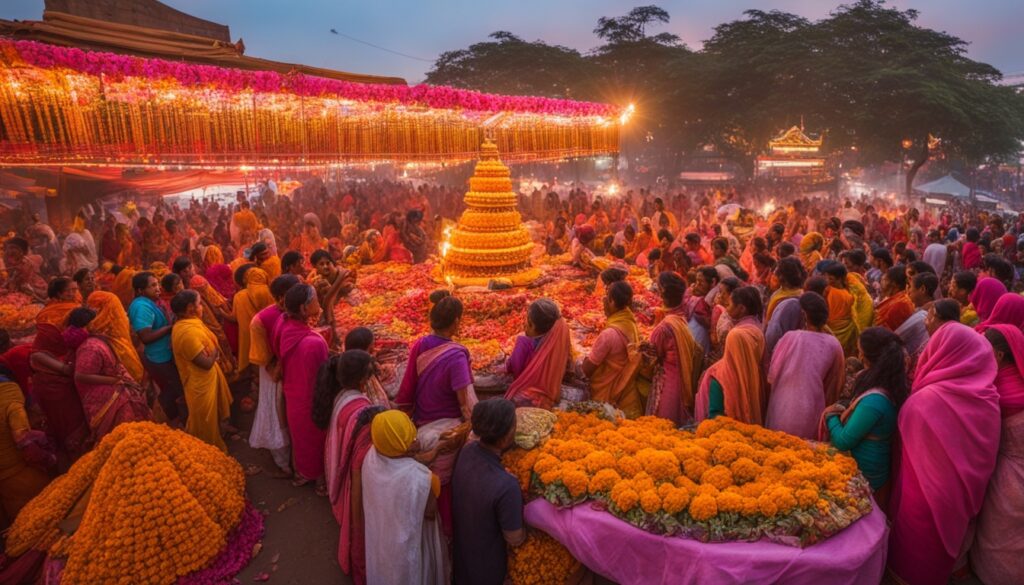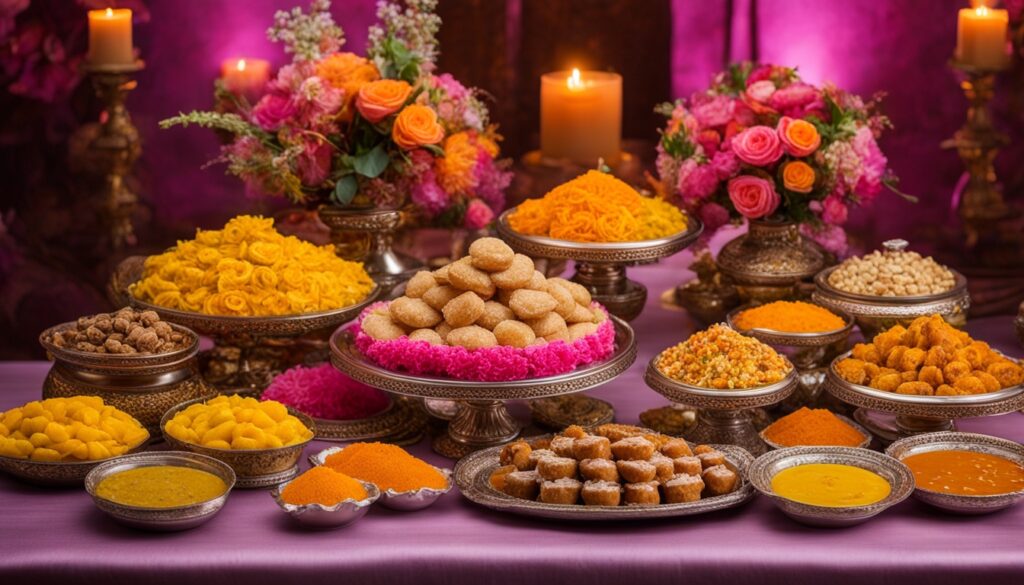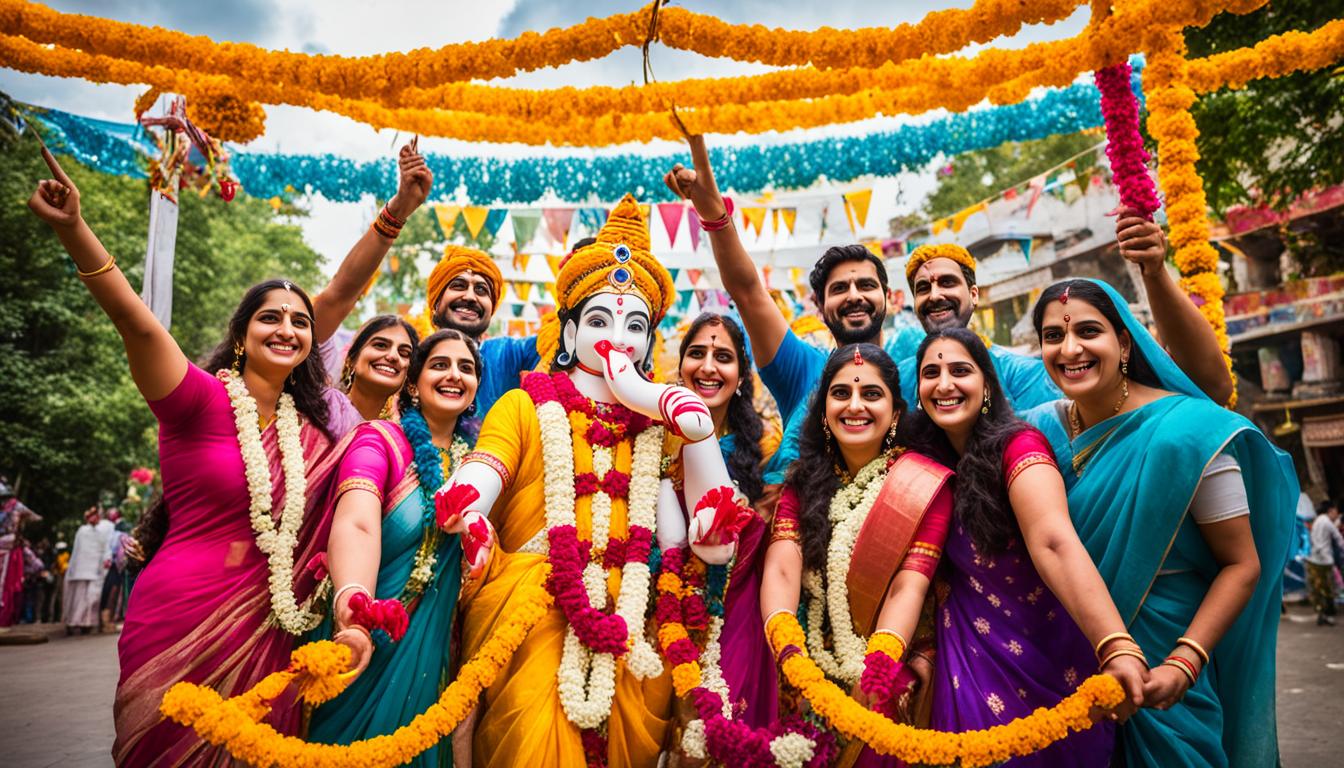Imagine a celebration that goes beyond time and tradition, honoring the birthday of the beloved Lord Krishna. Welcome to Janmastami, the Hindu festival that celebrates Krishna’s birth. This festival honors the eighth incarnation of Lord Vishnu, who has touched the hearts of many for centuries.
His life and teachings have left a deep spiritual and cultural mark. This legacy is still celebrated all over India today.
Key Takeaways
- Janmastami is the Hindu festival celebrating the birth of Lord Krishna, the beloved eighth incarnation of Lord Vishnu.
- The festival is observed with great fervor and devotion, especially in Mathura and Vrindavan, the scenes of Krishna’s childhood.
- Janmastami commemorates the events surrounding Krishna’s birth and his life as a mischievous cowherd, marked by rituals, celebrations, and the sharing of traditional sweets.
- The festival is known by various names, including Krishna Jayanti, Gokulashtami, and Shri Krishna Janmashtami.
- Celebrations include fasting, vigils, decorations, offerings, singing, dancing, and the sharing of delicacies like makhan mishri and laddu gopal.
What is Janmastami?
Janmastami, also known as Krishna Janmashtami or Shri Krishna Jayanti, is a special Hindu festival. It honors the birth of Lord Krishna. The name comes from ‘janma’ meaning ‘birth’ and ‘ashtami’ meaning ‘eighth’. This is because it falls on the eighth day of the dark fortnight in the Hindu month of Bhadrapada, usually in August or September.
Definition and Meaning
Janmastami is a key event in Hindu culture. It marks the birth of Lord Krishna, the eighth form of Lord Vishnu. Krishna came to Earth to fight evil and bring back right living during a dark time.
Historical Significance
For centuries, Janmastami has been a major festival. The first mentions of it are in ancient Sanskrit texts. It shows the deep love and respect Hindus have for Lord Krishna and his teachings.
| Janmastami Definition | Janmastami Meaning | Janmastami Historical Significance |
|---|---|---|
| A Hindu festival that celebrates the birth of Lord Krishna | The word ‘Janmastami’ is derived from the Sanskrit words ‘janma’ meaning ‘birth’ and ‘ashtami’ meaning ‘eighth’ | Janmastami commemorates the arrival of Lord Krishna, the eighth avatar of Lord Vishnu, on Earth to vanquish evil and restore dharma |
“Janmastami is a celebration of the divine love and wisdom embodied in Lord Krishna, whose life and teachings continue to inspire millions of devotees worldwide.”
The Birth of Lord Krishna
Lord Krishna was born in Mathura to Devaki and Vasudeva. This was during the rule of the cruel King Kamsa. Kamsa had locked up Devaki and Vasudeva because a prophecy said their eighth child would defeat him.
Mythological Accounts
On the night of Krishna’s birth, Vasudeva secretly took the baby to Gokul. There, he was adopted by Nanda and Yashoda. This move is a key part of Krishna’s story, showing how far parents will go to keep their child safe.
Significance of the Eighth Day
The number eight is very important in Krishna’s birth story. He was the eighth child of Devaki, and he was born on the eighth day of the moon cycle. This day is called Ashtami and is celebrated as Janmashtami, the festival of Krishna’s birth.
The eighth day is seen as sacred in Hinduism. It stands for completeness, balance, and new starts. Krishna’s birth on this day is seen as a sign of divine power, bringing hope and spiritual light.
“The birth of Lord Krishna on the eighth day is a testament to the power of divine intervention and the triumph of good over evil.”
Celebrations and Rituals
Janmastami, the birthday of Lord Krishna, is a big deal in India. People celebrate with lots of love and respect. They stay up all night, waiting for midnight, when Krishna was born.
They fast and do spiritual activities like chanting and singing. This makes the night special.
At midnight, the fun starts. People see the deity bathed with water and milk. Then, they dress the deity in beautiful clothes made of flowers and leaves. They give offerings like sweets to the deity, which they share with everyone later.
Fasting and Vigil
- People don’t eat or drink on Janmastami until midnight.
- They stay awake all night, singing and doing spiritual things.
- They eat after the midnight worship of the deity.
Decorations and Offerings
Temples and homes look amazing with rangoli, flower garlands, and colorful leaves. People give sweets, fruits, and incense to the deity. Then, they share these offerings with everyone.
| Janmastami Decorations | Janmastami Offerings |
|---|---|
| Rangoli designs | Makhan mishri |
| Flower garlands | Laddu gopal |
| Colorful leaves | Fruits |
| Diyas (oil lamps) | Incense |
“The essence of Janmastami lies in the devotion and reverence with which it is celebrated. Each ritual and custom is imbued with the spirit of Krishna’s divine presence.”
Festivities and Customs
Janmastami is a big celebration of Lord Krishna’s birth. It’s filled with customs and traditions. A key event is the Dahi Handi, where young men climb human pyramids to get to a pot of yogurt and sweets. This is inspired by Krishna’s fun times as a kid, when he loved to steal butter and yogurt.
Dahi Handi
The Dahi Handi festival shows how much community and teamwork matter. Young men, called “Govinda Pathaks,” try to make the tallest pyramids. They aim to break a pot full of treats hanging high up. It’s a fun way to remember Krishna’s playful side.
Singing and Dancing
Janmastami also brings joy with devotional singing and traditional dances. People sing songs that celebrate Krishna’s life. The Raslila dance tells stories of Krishna’s adventures. These activities bring people together, creating a strong sense of community and spiritual bond.
Janmastami is a colorful way to celebrate Lord Krishna’s birth. It’s filled with customs and traditions that show the joy and spirit of this important figure. From the exciting Dahi Handi to the beautiful singing and dancing, it’s a peek into India’s rich cultural heritage.
janmastami
Janmashtami is a big Hindu festival that celebrates the birth of Lord Krishna. It’s a time of great joy and devotion across India. This festival honors the birth of a god who is seen as an avatar of Lord Vishnu. People from all walks of life come together to celebrate and honor the divine child.
The name “Janmashtami” comes from the Sanskrit words “Janma” meaning “birth” and “Ashtami” meaning “the eighth day.” It’s celebrated on the eighth day of the Krishna Paksha (dark fortnight) in the Hindu month of Shravana. This usually happens in August or September.
| Significance of Janmashtami | Celebration Details |
|---|---|
|
|
Janmashtami is filled with vibrant customs and traditions. These customs show the deep love and respect for the divine child. People fast, pray all night, decorate, and make delicious foods. This festival mixes spiritual and cultural elements beautifully.
In the holy cities of Mathura and Vrindavan, Janmashtami is a big deal. These cities are where Lord Krishna was born and grew up. Many devotees come to these places to join in the fun and seek the deity’s blessings.
Janmashtami is a festival that brings people together, beyond just religious lines. It’s a time of rich traditions, lively celebrations, and deep spiritual meaning. This makes it a special and important event in the Hindu calendar.
Prominent Janmastami Celebrations
Janmastami, the birthday of Lord Krishna, is a big deal in India. It’s especially big in Mathura and Vrindavan, where Krishna was born and grew up. These places are the heart of the celebrations.
Mathura and Vrindavan
In Mathura and Vrindavan, Janmastami is a spectacle. The cities shine with lights and colors. They have dance shows, plays, and talks about spirituality. People fill the streets, singing Krishna’s name and joining in the fun.
Other Major Cities and Temples
But it’s not just Mathura and Vrindavan. Big cities and temples all over India celebrate Janmastami too. Places like the ISKCON temples in Delhi and Mumbai, the Shri Nathji Temple in Rajasthan, the Jagannath Temple in Odisha, and the Govind Dev Ji Temple in Jaipur have their own special ways of celebrating.

Janmastami is a time when people show how much they love Lord Krishna. It’s a celebration that reminds us of Krishna’s teachings and his lasting impact on us.
Significance and Symbolism
Janmastami is a big deal for the Hindu community. It’s the birthday of Lord Krishna, who is seen as the supreme deity and the eighth form of Lord Vishnu. People believe he came to Earth to fight evil and bring back justice.
During Janmastami, followers show their love and respect for Krishna in many ways. They fast, stay awake, decorate deities, and sing and dance in devotion. Each activity shows their wish to connect with Krishna’s divine spirit.
The janmastami significance goes beyond just being a religious event. It’s also a time to celebrate life, happiness, and the victory of good over bad. Krishna is seen as the ultimate symbol of wisdom, kindness, and love in Hindu philosophy.
“Krishna’s birth is not just a historical event, but a metaphor for the eternal dance of the divine and the human, where the divine constantly incarnates to uplift and guide humanity.”
Janmastami is a festival filled with rituals and traditions that have lasted for ages. It shows the strength of faith, devotion, and the wisdom of the divine in the Hindu community.
| Key Aspects of Janmastami Significance and Symbolism |
|---|
|
Janmastami Delicacies and Prasadam
Janmastami, the birth anniversary of Lord Krishna, is a time to enjoy many traditional and festive foods. These janmastami delicacies are more than just tasty treats. They are also seen as janmastami prasadam, or blessed offerings to the divine.
Makhan mishri is a favorite, made with creamy butter and sweet sugar crystals. Laddu gopal, small sweets shaped like Lord Krishna, are also loved. Along with sandesh, jalebi, and barfi, these sweets are key to the celebrations.
It’s a tradition to offer these janmastami delicacies to the deity first. This is a way to honor and thank the divine. Afterward, they are given to devotees. Eating these janmastami prasadam is believed to bring people closer to the divine and fill them with spiritual energy.
“The act of offering food to the divine, and then partaking of it, is a sacred ritual that connects the devotee to the divine essence of the festival.”
The janmastami delicacies and janmastami prasadam are more than just food. They show the deep cultural and spiritual roots of Janmastami celebrations.

Cultural Impact and Influence
Janmastami, the birthday of Lord Krishna, has deeply influenced Indian culture. It has woven traditions, customs, and art into Indian society. This has enriched the country’s cultural diversity and religious heritage.
Janmastami inspires many classical and folk dances. The Raslila, a dance drama, tells the story of Krishna and the Gopis. Bharatanatyam and Kathak dances also draw from Krishna’s life stories.
Janmastami has sparked a tradition of devotional music, literature, and art. Devotional songs and music are key parts of the festival. Krishna’s life has inspired stunning paintings and sculptures, adding to Janmastami’s cultural impact.
“Janmastami is not just a festival, but a celebration of the enduring spirit of Krishna’s timeless teachings and the cultural tapestry they have woven into the very fabric of India.”
Janmastami customs like fasting and decorating temples are common in India. These practices keep Krishna’s cultural legacy alive. They ensure his teachings inspire and guide future generations.
Janmastami in Modern Times
The celebration of Janmastami, the birthday of Lord Krishna, has changed with the times. Yet, the traditional rituals and customs are still key to this Hindu festival. Now, there’s more focus on community, caring for the environment, and modern art.
Many groups and temples now host workshops, cultural events, and charity drives for Janmastami. These efforts make the festival more welcoming for young people. It also keeps the festival’s spirit alive as the next generation gets involved.
There’s a big push for sustainability in modern Janmastami celebrations. You’ll see eco-friendly decorations and efforts to reduce waste. This shows how important it is to protect our planet.
At contemporary Janmastami events, you’ll find new art forms too. Things like fusion music, interactive art, and digital stories are now part of the fun. They attract young people and bring a new vibe to the festival.
“The true essence of Janmastami lies not just in the rituals but in the spirit of community, compassion, and cultural celebration that it fosters. As we move forward, it is essential to strike a balance between preserving the timeless traditions and adapting to the evolving needs of society.”
Janmastami keeps changing but still shows the strength of Hindu culture. It proves that old traditions can still be alive and well in today’s fast-paced world.
Conclusion
Janmastami, the celebration of Lord Krishna’s birth, shows the lasting power of Hindu devotion. It highlights the timeless appeal of this much-loved deity. The festival is filled with rich traditions and deep spiritual meaning.
During the annual celebrations, Janmastami reminds us of Krishna’s key values: love, compassion, and a strong purpose. The rituals, music, and community spirit bring out the true essence of the festival. This ensures that Krishna’s teachings and life stay alive in followers’ hearts.
In cities like Mathura and Vrindavan, or in celebrations worldwide, Janmastami is a key part of Hindu culture and spirituality. As the festival ends, it leaves behind hope and inspiration. This guides devotees in their search for self-discovery and devotion to the divine.
FAQ
What is Janmastami?
Janmastami is a big Hindu festival. It celebrates the birth of Lord Krishna, who is the eighth form of Lord Vishnu. People in India, especially in Mathura and Vrindavan, celebrate it with lots of love and devotion.
When is Janmastami celebrated?
Janmastami is on the eighth day of the dark fortnight in the Hindu month of Bhadrapada. This usually falls in August or September.
What is the significance of the number eight in Janmastami?
The number eight is important in Janmastami. It’s because Krishna was the eighth child of Devaki. His birth on the eighth day of the lunar cycle is seen as very lucky.
How do people celebrate Janmastami?
People celebrate Janmastami in many ways. They fast until midnight, decorate temples and homes, and give out traditional sweets. They also sing devotional songs and act out Krishna’s fun times as a child.
Where are the major Janmastami celebrations held?
Mathura and Vrindavan are the main places for Janmastami celebrations. Other big cities and temples like ISKCON in Delhi and Mumbai also celebrate it a lot. The Shri Nathji Temple in Rajasthan, the Jagannath Temple in Odisha, and the Govind Dev Ji Temple in Jaipur are also important places for the festival.
What is the spiritual and cultural significance of Janmastami?
Janmastami is very important to Hindus. It celebrates the birth of Krishna, who is seen as the highest deity and the eighth form of Lord Vishnu. The festival’s rituals show how much devotees love and respect Krishna.
What are the traditional delicacies associated with Janmastami?
Traditional foods for Janmastami include makhan mishri, laddu gopal, and sweets like sandesh and jalebi. These are first given to Krishna and then shared with devotees.
How has Janmastami influenced the cultural landscape of India?
Janmastami has deeply influenced Indian culture. It has inspired art, music, literature, and dance. The festival’s customs have become part of Indian life, adding to the country’s rich culture and religious traditions.
How is Janmastami celebrated in modern times?
Today, Janmastami is still celebrated with its traditional ways. But, it also includes new things like community events and caring for the environment. Modern art and music are also part of the festival now.
